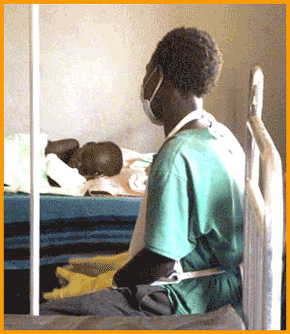Though in developing countries, AIDS (link) and tuberculosis often occur subsequently to one another, the two diseases are quite dissimilar. For one, tuberculosis has been around and deadly for much longer than AIDS, with the first known instances occurring in humans a little less than 5000 years ago. As such, there has been rather more time for the battle against tuberculosis to be fought than that against AIDS, and while the disease remains deadly and highly contagious, it is easily avoided through vaccination. The disease reached its peak pandemic levels in the 19th and early 20th century among the urban poor, due to close quarters, substandard living conditions and lack of hygiene (link). Its symptoms are usually pulmonary, and include coughing up blood, exhaustion, fever, chills, weight loss, pallor, etc. It is also spread through aerosols from coughing or sneezing--thus, very easily transmitted. However, as the disease rose in strength, it also rose in priority, and hygienic measures were increased to prevent the spread of the disease; vaccinations and treatments were simultaneously produced. The Bacille Calmette-Guérin vaccine was developed in the early 1900s at the Pasteur Institute in France, and made internationally available after World War II.
A TB patient and his caretaker.
By 1950, the death rate of those with the disease had dropped by approximately 90% from 100 years previous. A successful cure for the disease eventually became possible in 1946 with the development of streptomycin, an antibiotic. Isoniazid and rifampicin later replaced this early treatment, and remain the two most effective antibiotic treatments, or "first-line" drugs, for TB.
However, the complete elimination of the disease was made impossible by a resurgence in the 1980s, and the emergence of a new strain: Multi-drug-resistant, or MDR, tuberculosis. Partially a result of lax public health or TB control programs, the disease gained footing among the people of developing nations in South America, Russia, and South-East Asia especially. It is this new, deadlier version of the disease that PIH concerns itself with most often; MDR TB is resistant to the two most common antibiotic treatments for TB, and as a result very difficult and expensive to overcome. It is therefore more practical to attempt to prevent its development; usually, the disease develops in a patient who already has normal tuberculosis, and grows as a result of sporadic treatment, missed medication, or failure to complete the medication cycle. While MDR TB is treatable, and not necessarily a death sentence, treatment regimens are long, complicated, and expensive, and require an often unrealistic amount of physician involvement--therefore, the prognosis is generally bleak, especially in developing countries; even with optimal treatment, the disease is frequently fatal.
Despite such daunting obstacles, PIH has focused much of its time and (limited) resources on the battlement of the MDR TB. Working from an existing model of treatment which has been shown to better recovery rates, namely the practice of having patients be medicated under the direct supervision of qualified healthcare personnel (Directly Observed Therapy, or DOT), PIH developed the world's first community-based infrastructure to facilitate TB treatment. They launched the prototype program in Lima, Peru (link), where an epidemic of MDR TB had become serious, in 1996. Though lacking in resources and government support, PIH successfully developed a healthcare community by hiring and training locals to accompany patients through the long and difficult healing process. This comprehensive approach to cure, combined with the generous gift of second-line drugs from the Brigham Hospital, produced an 83% recovery rate, one of the highest in the world.
This example of successful treatment, essentially a clinical trial, proved a convincing argument against the skeptics of the world. The World Health Organization, originally unconvinced of the practicality of MDR TB treatment, began approving the treatment program on a country-by-country basis for international implementation in 2002. The program was later brought to Siberia, where the rate of MDR TB is one of the highest in the world. PIH-Russia has since implemented the program in prisons and communities throughout the area, and plans, in conjunction with other organizations such as the U.S. Center for Disease Control and Prevention, to raise the number of patients under PIH's model of treatment to 800,000 worldwide by 2015.


